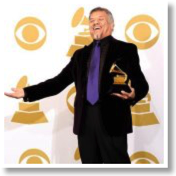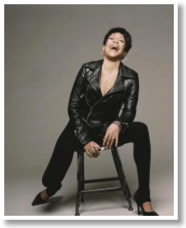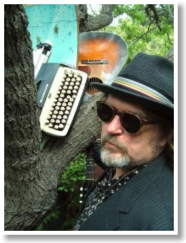January 2013
Little Joe Y La Familia
Little Joe Y La Familia
Antone’s
Austin, Texas
José María De León Hernández, better known as “Little Joe” of Little Joe Y La Familia, first started his Tejano music career with his cousin David Coronado in a group called David Coronado & The Latinaires. As the years went on, Little Joe would later take over the group and rename it Little Joe Y La Familia, meaning “Little Joe and the family,” as his cultural values of family unity gained more prominence in his music.
There was little space on the dance floor as Little Joe Y La Familia took over Antone’s Wednesday evening. Little Joe did well to keep an audience awake and active by incorporating as much enthusiasm into his songs as possible with the occasional grito (a Mexican celebratory call like “yahoo”) and connecting with his audience in English between his songs. Most of the songs performed included popular themes such as personal struggles within songs like “Cartas Marcadas.” The music was characterized by the controlled sound of orchestral instruments, which offered a more traditional and well-rounded Tejano sound when accompanied by the various guitarists, drums and synthesizer.
 Little Joe has been recognized as a two-time Grammy award winner, first in 1992 with the album Diez y Seis de Septiembre for best Mexican-American performance and again in 2008 with the album Before the Next Teardrop Falls for best Tejano album of the year. Today, Little Joe is still performing at various venues across the U.S., breaking down barriers and delivering messages of peace, love and harmony to his fans across the world.
Little Joe has been recognized as a two-time Grammy award winner, first in 1992 with the album Diez y Seis de Septiembre for best Mexican-American performance and again in 2008 with the album Before the Next Teardrop Falls for best Tejano album of the year. Today, Little Joe is still performing at various venues across the U.S., breaking down barriers and delivering messages of peace, love and harmony to his fans across the world. 
by Michelle Marie Garcia
Antone’s
Austin, Texas
José María De León Hernández, better known as “Little Joe” of Little Joe Y La Familia, first started his Tejano music career with his cousin David Coronado in a group called David Coronado & The Latinaires. As the years went on, Little Joe would later take over the group and rename it Little Joe Y La Familia, meaning “Little Joe and the family,” as his cultural values of family unity gained more prominence in his music.
There was little space on the dance floor as Little Joe Y La Familia took over Antone’s Wednesday evening. Little Joe did well to keep an audience awake and active by incorporating as much enthusiasm into his songs as possible with the occasional grito (a Mexican celebratory call like “yahoo”) and connecting with his audience in English between his songs. Most of the songs performed included popular themes such as personal struggles within songs like “Cartas Marcadas.” The music was characterized by the controlled sound of orchestral instruments, which offered a more traditional and well-rounded Tejano sound when accompanied by the various guitarists, drums and synthesizer.

by Michelle Marie Garcia
Bettye LaVette
Bettye LaVette
Jo Long Theatre, Carver Community Cultural Center
San Antonio, Texas
One of the greatest soul music singers of all time, Detroit-raised Bettye LaVette may not be a familiar name to many, but she is living proof of success in music through her cult following for over 50 years. With a few certified classics in her discography (“My Man – He’s a Lovin’ Man,” “He Made a Woman Out of Me,” “Doin’ The Best That I Can,” and “Let Me Down Easy”), her voice has graced the historic imprints Atlantic and Motown. And her songs were recorded by Joe Cocker, the Spencer Davis Group, Bobbie Gentry, and Jeannie C. Riley, and she toured with James Brown, Otis Redding, and Clyde McPhatter (of the Dominoes’ and Drifters’ fame), even performing with Jon Bon Jovi and Paul McCartney. She has been nominated for several Grammys, won recognition from The Rhythm & Blues Foundation and the W.C. Handy Award, was lauded by various publications such as The New York Times, served as a guest on several television talk shows, and performed for President Obama.
 Dressed in her usual black gown and a lethal combination of attitude, sass, and verve, Bettye wringed out every emotion with such integrity that she made the cover of songs her own, whether it was Bob Dylan’s “Everything Is Broken,” The Beatles’ “The Word,” Dolly Parton’s “Little Sparrow,” The Black Keys’ “I’m Not the One,” and Renee Geyer’s “Heaven (The Closest I’ll Get).” She ended the show with a striking a cappella version of Sinead O’Connor’s “I Do Not Want What I Haven’t Got” that was met with a standing ovation. Again, here stood a woman who had mesmerized audiences after performing Pete Townshend’s “Love, Reign o’er Me” at the 2008 Kennedy Center Honors in recognition of The Who.
Dressed in her usual black gown and a lethal combination of attitude, sass, and verve, Bettye wringed out every emotion with such integrity that she made the cover of songs her own, whether it was Bob Dylan’s “Everything Is Broken,” The Beatles’ “The Word,” Dolly Parton’s “Little Sparrow,” The Black Keys’ “I’m Not the One,” and Renee Geyer’s “Heaven (The Closest I’ll Get).” She ended the show with a striking a cappella version of Sinead O’Connor’s “I Do Not Want What I Haven’t Got” that was met with a standing ovation. Again, here stood a woman who had mesmerized audiences after performing Pete Townshend’s “Love, Reign o’er Me” at the 2008 Kennedy Center Honors in recognition of The Who.
In an hour performance, Bettye LaVette captured the essence of a great song interpreter, continuing the tradition of R&B/soul artists covering rock music material to acclaim and success. And she did it with musical phrasing that seemed effortless to the ears.
by Jeff Boyce
Jo Long Theatre, Carver Community Cultural Center
San Antonio, Texas
One of the greatest soul music singers of all time, Detroit-raised Bettye LaVette may not be a familiar name to many, but she is living proof of success in music through her cult following for over 50 years. With a few certified classics in her discography (“My Man – He’s a Lovin’ Man,” “He Made a Woman Out of Me,” “Doin’ The Best That I Can,” and “Let Me Down Easy”), her voice has graced the historic imprints Atlantic and Motown. And her songs were recorded by Joe Cocker, the Spencer Davis Group, Bobbie Gentry, and Jeannie C. Riley, and she toured with James Brown, Otis Redding, and Clyde McPhatter (of the Dominoes’ and Drifters’ fame), even performing with Jon Bon Jovi and Paul McCartney. She has been nominated for several Grammys, won recognition from The Rhythm & Blues Foundation and the W.C. Handy Award, was lauded by various publications such as The New York Times, served as a guest on several television talk shows, and performed for President Obama.

In an hour performance, Bettye LaVette captured the essence of a great song interpreter, continuing the tradition of R&B/soul artists covering rock music material to acclaim and success. And she did it with musical phrasing that seemed effortless to the ears.
by Jeff Boyce
Peter Case
Peter Case
Cactus Café
Austin, Texas
Singer, song-writer, producer and guitarist Peter Case remembers beginning his music career at an early age after his mother bought him a Mickey Mouse ukulele as his very first instrument. As he grew older, aspirations of becoming the next Elvis Presley motivated Case to travel the U.S. until he joined the Nerves in 1976. Four years later, after the Nerves disbanded, Case helped found the Plimsouls but later left to start on what has been an extensively successful solo career. Since then, Case has been nominated for Grammy Awards for his solo music twice and in 1986 had his album titled Peter Case named best record of the year by The New York Times.
 Case also entertained his audience with intricate stories of his youth and journey between songs. For example, songs like “Million Dollars Bail” and “Ain’t Gonna Worry No More” mix in themes from times when Case was traveling to San Francisco as young adult all on his own. Other songs like “House Rent Party” showcase Case’s variety in sound and ability to switch moods at the drop of a hat as he goes from an easy flowing folk tune to more of an elaborate indie-rock song. What was most interesting, however, was the way Case lowered a guitar string’s tuning until it was but a raw thump when plucked. The cacophonous noise was then transformed into a creatively innovative drone bass line in “Thirty Days in the Workhouse,” proving Case to be quite the inventive musician.
Case also entertained his audience with intricate stories of his youth and journey between songs. For example, songs like “Million Dollars Bail” and “Ain’t Gonna Worry No More” mix in themes from times when Case was traveling to San Francisco as young adult all on his own. Other songs like “House Rent Party” showcase Case’s variety in sound and ability to switch moods at the drop of a hat as he goes from an easy flowing folk tune to more of an elaborate indie-rock song. What was most interesting, however, was the way Case lowered a guitar string’s tuning until it was but a raw thump when plucked. The cacophonous noise was then transformed into a creatively innovative drone bass line in “Thirty Days in the Workhouse,” proving Case to be quite the inventive musician.
Today, Case has expanded his fan base by winning over the hearts of thousands all over the world. He continues to tour and expand his solo career, growing alongside his music as he discovers new ways to further develop his music.
by Michelle Marie Garcia
Cactus Café
Austin, Texas
Singer, song-writer, producer and guitarist Peter Case remembers beginning his music career at an early age after his mother bought him a Mickey Mouse ukulele as his very first instrument. As he grew older, aspirations of becoming the next Elvis Presley motivated Case to travel the U.S. until he joined the Nerves in 1976. Four years later, after the Nerves disbanded, Case helped found the Plimsouls but later left to start on what has been an extensively successful solo career. Since then, Case has been nominated for Grammy Awards for his solo music twice and in 1986 had his album titled Peter Case named best record of the year by The New York Times.

Today, Case has expanded his fan base by winning over the hearts of thousands all over the world. He continues to tour and expand his solo career, growing alongside his music as he discovers new ways to further develop his music.
by Michelle Marie Garcia
Miró String Quartet and
Shanghai String Quartet
Miró String Quartet and Shanghai String Quartet
McCullough Theatre
Austin, Texas
It is a rare treat to witness the performance of a world class string quartet on stage. It is an even greater treat to watch the performance of two world class string quartets on stage together. McCullough theatre was completely full on a Friday night with concert-goers of all ages. The semi-circle of eight empty chairs and music stands on stage were soon filled with eight men in black suits holding polished orange instruments. From left to right sat the two pairs of violinists, then the two violists, and finally the two cellists on the far left—a typical octet setting. They took a breath together in the split second before the rosin hit the string and Shostakovich’s “Two Pieces for String Quartet” began. As the harmonies beautifully leapt and flowed between the instruments of the octet, it became hard to imagine that these two quartets did not perform together all of the time.
Dan Welcher’s “Museon Polemos” (“War of the Muses”) followed the Shostakovich piece, and it truly stole the show. For quite a few reasons, it was very different than the Shostakovich piece and the Mendelssohn piece that was to be played after the intermission: the eight players were rearranged to sit in two straight rows of four, angled in a wide upside-down V facing the audience with about a 4 foot gap in between each row; the two quartets sat apart from each other; it was the piece’s world premiere; and the composer was in the audience. Before the quartets played the song, they called the composer onto the stage for recognition and a chance to speak his thoughts and thought process on the music. He explained that this song and seating arrangement reflected two warring personalities, one aristocratic and one rough and bold. The performance was playful and a bit theatric as the quartets flaunted and challenged back and forth. With its unique style and intriguing themes, “Museon Polemos” was a great way to end the first half.
After the break, the octet returned to their original formation and performed Mendelssohn’s “Octet in E flat major, Op. 20.” Again the quartets’ talent showed through as the melodies swept through each of the instruments. The night ended in standing ovation after ovation for the three truly impressive exhibitions of performance and composition.
by Olivia Lin
McCullough Theatre
Austin, Texas
It is a rare treat to witness the performance of a world class string quartet on stage. It is an even greater treat to watch the performance of two world class string quartets on stage together. McCullough theatre was completely full on a Friday night with concert-goers of all ages. The semi-circle of eight empty chairs and music stands on stage were soon filled with eight men in black suits holding polished orange instruments. From left to right sat the two pairs of violinists, then the two violists, and finally the two cellists on the far left—a typical octet setting. They took a breath together in the split second before the rosin hit the string and Shostakovich’s “Two Pieces for String Quartet” began. As the harmonies beautifully leapt and flowed between the instruments of the octet, it became hard to imagine that these two quartets did not perform together all of the time.
Dan Welcher’s “Museon Polemos” (“War of the Muses”) followed the Shostakovich piece, and it truly stole the show. For quite a few reasons, it was very different than the Shostakovich piece and the Mendelssohn piece that was to be played after the intermission: the eight players were rearranged to sit in two straight rows of four, angled in a wide upside-down V facing the audience with about a 4 foot gap in between each row; the two quartets sat apart from each other; it was the piece’s world premiere; and the composer was in the audience. Before the quartets played the song, they called the composer onto the stage for recognition and a chance to speak his thoughts and thought process on the music. He explained that this song and seating arrangement reflected two warring personalities, one aristocratic and one rough and bold. The performance was playful and a bit theatric as the quartets flaunted and challenged back and forth. With its unique style and intriguing themes, “Museon Polemos” was a great way to end the first half.
After the break, the octet returned to their original formation and performed Mendelssohn’s “Octet in E flat major, Op. 20.” Again the quartets’ talent showed through as the melodies swept through each of the instruments. The night ended in standing ovation after ovation for the three truly impressive exhibitions of performance and composition.
by Olivia Lin


